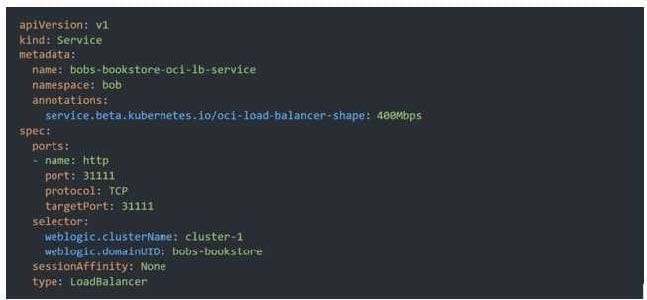Exam Details
Exam Code
:1Z0-1084-21Exam Name
:Oracle Cloud Infrastructure Developer 2021 AssociateCertification
:Oracle CertificationsVendor
:OracleTotal Questions
:72 Q&AsLast Updated
:Jun 22, 2025
Oracle Oracle Certifications 1Z0-1084-21 Questions & Answers
-
Question 61:
A developer using Oracle Cloud Infrastructure (OCI) API Gateway must authenticate the API requests to their web application. The authentication process must be implemented using a custom scheme which accepts string parameters from the API caller. Which method can the developer use In this scenario?
A. Create an authorizer function using request header authorization.
B. Create an authorizer function using token-based authorization.
C. Create a cross account functions authorizer.
D. Create an authorizer function using OCI Identity and Access Management based authentication
-
Question 62:
You have written a Node.js function and deployed it to Oracle Functions. Next, you need to call this
function from a microservice written in Java deployed on Oracle Cloud Infrastructure (OCI) Container
Engine for Kubernetes (OKE).
Which can help you to achieve this?
A. Use the OCI CLI with kubect1 to invoke the function from the microservice.
B. Oracle Functions does not allow a microservice deployed on OKE to invoke a function.
C. OKE does not allow a microservice to invoke a function from Oracle Functions.
D. Use the OCI Java SDK to invoke the function from the microservice.
-
Question 63:
Which Oracle Cloud Infrastructure (OCI) load balancer shape is used by default in OCI container Engineer for Kubernetes?
A. 400 Mbps
B. 8000 Mbps
C. There is no default. The shape has to be specified.
D. 100 Mbps
-
Question 64:
Which statement accurately describes Oracle Cloud Infrastructure (OCI) Load Balancer integration with OCI Container Engine for Kubernetes (OKE)?
A. OKE service provisions an OCI Load Balancer instance for each Kubernetes service with LoadBalancer type in the YAML configuration.
B. OCI Load Balancer instance provisioning is triggered by OCI Events service for each Kubernetes service with LoadBalancer type in the YAML configuration.
C. OCI Load Balancer instance must be manually provisioned for each Kubernetes service that requires traffic balancing.
D. OKE service provisions a single OCI Load Balancer instance shared with all the Kubernetes services with LoadBalancer type in the YAML configuration.
-
Question 65:
A pod security policy (PSP) is implemented in your Oracle Cloud Infrastructure Container Engine for Kubernetes cluster Which rule can you use to prevent a container from running as root using PSP?
A. NoPrivilege
B. RunOnlyAsUser
C. MustRunAsNonRoot
D. forbiddenRoot
-
Question 66:
You are working on a serverless DevSecOps application using Oracle Functions. You have deployed a Python function that uses the Oracle Cloud Infrastructure (OCI) Python SDK to stop any OC1 Compute instance that does not comply with your corporate security standards There are 3 non compliant OCI Compute instances. However, when you invoke this function none of the instances were stopped. How should you troubleshoot this?
A. There is no way to troubleshoot a function running on Oracle Functions.
B. Enable function logging in the OCI console, include some print statements in your function code and use logs to troubleshoot this.
C. Enable function remote debugging in the OCI console, and use your favorite IDE to inspect the function running on Oracle Functions.
D. Enable function tracing in the OCI console, and go to OCI Monitoring console to see the function stack trace.
-
Question 67:
You are building a cloud native, serverless travel application with multiple Oracle Functions in Java, Python and Node.js. You need to build and deploy these functions to a single applications named travel-app. Which command will help you complete this task successfully?
A. oci fn function deploy --ap travel-ap --all
B. fn deploy --ap travel-ap -- all
C. oci fn application --application-name-ap deploy --all
D. fn function deploy --all --application-name travel-ap
-
Question 68:
You are a consumer of Oracle Cloud Infrastructure (OCI) Streaming service. Which API should you use to read and process the stream?
A. ListMessages
B. GetMessages
C. GetObject
D. ReadMessages
-
Question 69:
Which two handle Oracle Functions authentication automatically?
A. Oracle Cloud Infrastructure SDK
B. cURL
C. Oracle Cloud Infrastructure CLl
D. Signed HTTP Request
E. Fn Project CLI
-
Question 70:
Which two statements accurately describe an Oracle Functions application?
A. A small block of code invoked in response to an Oracle Cloud Infrastructure (OCI) Events service
B. A Docker image containing all the functions that share the same configuration
C. An application based on Oracle Functions, Oracle Cloud Infrastructure (OCI) Events and OCI API Gateway services
D. A common context to store configuration variables that are available to all functions in the application
E. A logical group of functions
Related Exams:
1Z0-020
Oracle8i: New Features for Administrators1Z0-023
Architecture and Administration1Z0-024
Performance Tuning1Z0-025
Backup and Recovery1Z0-026
Network Administration1Z0-034
Upgrade Oracle9i/10g OCA to Oracle Database OCP1Z0-036
Managing Oracle9i on Linux1Z0-041
Oracle Database 10g: DBA Assessment1Z0-052
Oracle Database 11g: Administration Workshop I1Z0-053
Oracle Database 11g: Administration II
Tips on How to Prepare for the Exams
Nowadays, the certification exams become more and more important and required by more and more enterprises when applying for a job. But how to prepare for the exam effectively? How to prepare for the exam in a short time with less efforts? How to get a ideal result and how to find the most reliable resources? Here on Vcedump.com, you will find all the answers. Vcedump.com provide not only Oracle exam questions, answers and explanations but also complete assistance on your exam preparation and certification application. If you are confused on your 1Z0-1084-21 exam preparations and Oracle certification application, do not hesitate to visit our Vcedump.com to find your solutions here.

